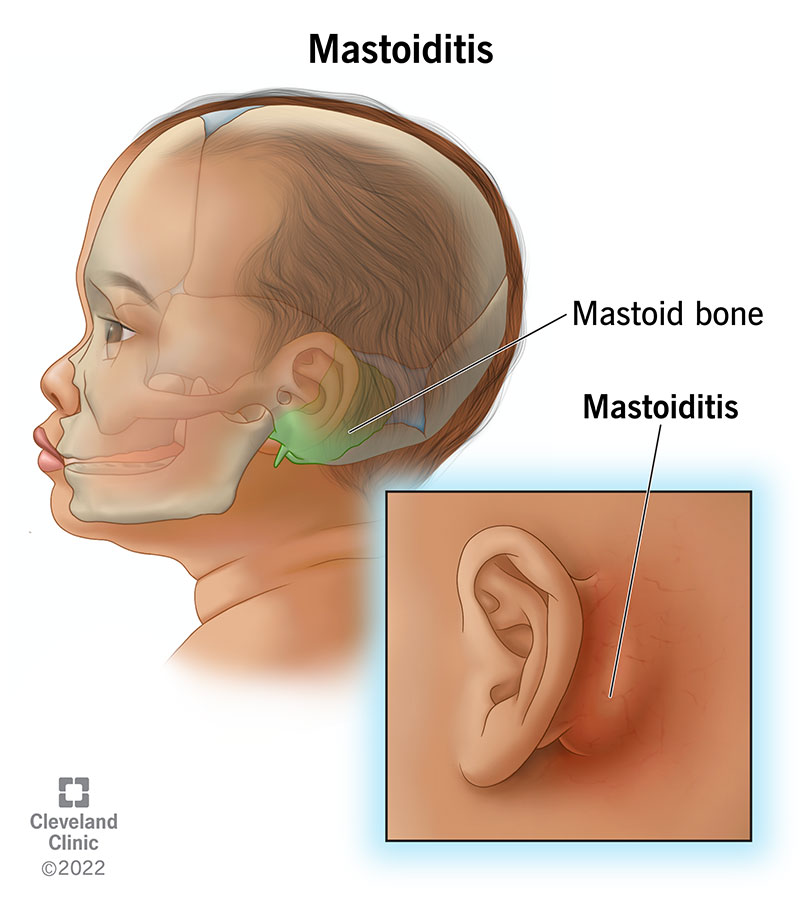Mastoiditis is an infection of part of your temporal bone, the large bone behind your ear. It happens when middle ear infections spread to that area. Symptoms include ear pain, drainage and trouble hearing. Healthcare providers treat mastoiditis with antibiotics and by draining the infected middle ear fluid. Serious cases require surgery.
Advertisement
Cleveland Clinic is a non-profit academic medical center. Advertising on our site helps support our mission. We do not endorse non-Cleveland Clinic products or services. Policy

Mastoiditis is a bacterial infection in a part of your temporal bone — the big bone behind your ear. Mastoiditis starts as a middle ear infection. It once was a common cause of death in very young children. Now, thanks to vaccinations that prevent infections and antibiotics that cure them, mastoiditis is a rare condition.
Advertisement
Cleveland Clinic is a non-profit academic medical center. Advertising on our site helps support our mission. We do not endorse non-Cleveland Clinic products or services. Policy
But you can still get mastoiditis if you have an untreated middle ear infection. Although anyone can get mastoiditis at any age, children 2 years old and younger are especially vulnerable. It’s important to know the signs of mastoiditis so that you can seek treatment for yourself or your child as soon as possible.
There are two types of mastoiditis:
Usually, symptoms of mastoiditis develop days or weeks after a middle ear infection. Mastoiditis symptoms include:
In addition to the symptoms above, very young children — children ages 2 and younger — may pull their affected ear and be fussy or less active.
Advertisement
Mastoiditis typically happens when middle ear infections go untreated, allowing the infection to spread into the nearby bone.
Rarely, people develop mastoiditis without a middle ear infection. This happens when a condition called cholesteatoma causes mastoiditis. Cholesteatoma is an abnormal skin growth in your middle ear. It can block fluids that need to drain from your middle ear and lead to mastoiditis.
Without treatment, the infection can spread and cause complications like:
Life-threatening complications from mastoiditis are much less common than they once were. Still, it’s important to get treatment immediately to avoid long-term issues.
A healthcare provider will use an otoscope to look inside your ear. They may also do the following tests:
Often, healthcare providers treat mastoiditis with antibiotics and steroids. If your middle ear isn’t draining infected fluid on its own, they’ll perform a myringotomy. For this procedure, a provider makes a tiny hole in your eardrum, so the fluid gathered behind it can drain. They may place small, hollow cylinders called ear tubes into the hole, so the fluid can continue to seep out. The ear tubes usually fall out on their own within six months to a year.
If these treatments don’t help or there’s a pocket of pus (abscess) in part of your temporal bone, you may need surgery (mastoidectomy) to remove the infected bone.
Usually, mastoiditis symptoms go away a few days after you or your child starts taking antibiotics. It’s important to finish taking all antibiotics as prescribed so the infection doesn’t come back.
For severe cases, you or your child may need follow-up appointments to check for long-term hearing loss.
The best thing you can do to reduce your risk of mastoiditis is to get treated for ear infections ASAP. You can also take steps to protect your child from infections. You can:
Advertisement
Follow your healthcare provider’s instructions about caring for yourself or your child after treatment. For example, you may need to avoid swimming for a while to keep water out of your ear. You may need to put a cotton ball lined with petroleum jelly (like Vaseline®) in your ear when you’re bathing or showering to keep water out.
Your provider will tell you what to do.
Contact a healthcare provider if you or your child has symptoms of an ear infection, like ear pain that doesn’t improve. Ear infections are treatable. But ignoring symptoms can allow the infection to spread.
Questions to ask include:
Years ago, mastoiditis was a common, serious illness that could be fatal for very young children. Now, we have vaccinations to prevent the middle ear infection that causes mastoiditis. And we have antibiotics to treat those infections. Take steps to protect you and your child from developing ear infections. If you think you or your child has a middle ear infection, contact a healthcare provider to get treatment and reduce the risk of mastoiditis.
Advertisement
If you have conditions affecting your ears, nose and throat, you want experts you can trust. Cleveland Clinic’s otolaryngology specialists can help.

Last reviewed on 01/18/2025.
Learn more about the Health Library and our editorial process.